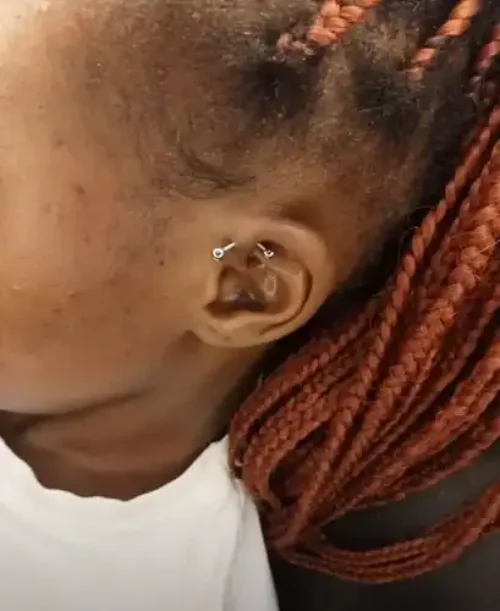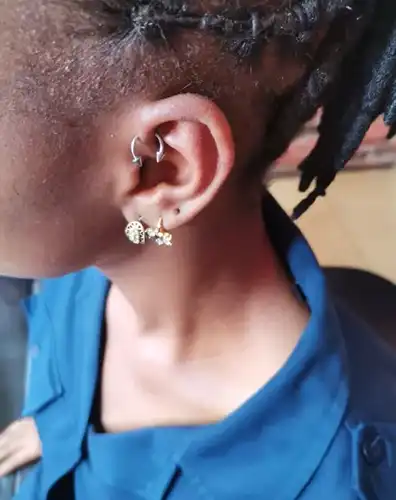Foward Helix Piercing
Key Features of a Forward Helix Piercing
- Location: The outer rim of the ear, near where it meets the face.
- Jewelry Options: Small studs, flat-back earrings, or delicate hoops.
- Healing Time: Typically 6–9 months, depending on aftercare and anatomy.
- Pain Level: Moderate, as it involves cartilage. Pain varies based on individual tolerance.
Considerations before getting a Foward Helix Piercing
Getting a forward helix piercing is a personal choice, but it’s important to carefully consider several factors before going through with the procedure. Here are some considerations to keep in mind:
- Pain Tolerance: Piercings can be painful, and the forward helix is known to be more sensitive compared to some other ear piercings. Consider your pain tolerance and how well you handle discomfort.
- Healing Time: Piercings take time to heal. A forward helix piercing typically takes around 6-12 months to fully heal. During this period, you’ll need to follow aftercare instructions diligently.
- Aftercare Commitment: Proper aftercare is crucial for preventing infections and complications. You’ll need to clean the piercing regularly, avoid touching it with dirty hands, and refrain from swimming in pools or hot tubs during the healing process.
- Piercing Studio Selection: Choose a reputable and licensed piercing studio with experienced professionals who follow strict hygiene and safety protocols. Check online reviews and ask for recommendations from friends.
- Allergies and Sensitivities: Ensure you’re not allergic to the metal used for the jewelry. Titanium and surgical stainless steel are common options for initial piercings as they are less likely to cause allergic reactions.
- Jewelry Options: Decide on the type of jewelry you want for your forward helix piercing. Studs, rings, and hoops are common choices. Be aware that certain jewelry types may have different healing requirements.
- Placement and Aesthetic: Discuss the placement and style of the piercing with your piercer. Make sure it complements your overall aesthetic and fits well with other piercings you may have.
- Lifestyle Considerations: Think about your daily activities and whether they may affect the healing process. Activities like contact sports or wearing headphones may require some adjustments.
- Pain Management: Consider how you will manage pain and discomfort after the piercing. Over-the-counter pain relievers may be necessary for the first few days.
- Potential Complications: Be aware of potential complications, such as keloids, hypertrophic scarring, and infection. Knowing the signs and symptoms of these issues can help you address them promptly.
- Consultation with a Piercer: Before getting the piercing, consult with a professional piercer. They can assess your ear anatomy, discuss the process, and answer any questions or concerns you may have.
- Budget: Piercings can vary in cost depending on the studio, jewelry, and location. Make sure you’re prepared to cover the expenses associated with the piercing and any follow-up appointments.
Foward Helix Piercing Procedure
A forward helix piercing is a type of ear piercing that goes through the outer rim of the ear cartilage in the upper portion of the ear, near the temple area. Here’s an overview of what you can expect during the forward helix piercing procedure:
- Choosing a Piercing Studio: Start by selecting a reputable piercing studio. Research studios in your area, read reviews, and ask for recommendations from friends or online piercing communities.
- Consultation: When you arrive at Rebel Inks Tattoo and Piercings Parlour, you will have a consultation with a professional piercer. During this consultation, you can discuss your preferences for jewelry, placement, and any concerns or questions you may have.
- Sterilization:Your piercer will follow strict hygiene and sterilization protocols to ensure a clean and safe procedure. This includes using sterilized equipment and wearing disposable gloves.
- Marking: Before the actual piercing, your piercer will mark the precise location on your ear where the piercing will be placed. This ensures proper alignment and symmetry.
- Cleaning: Your piercer will clean the area around your ear and the ear itself with an antiseptic solution to minimize the risk of infection.
- Piercing: Your piercer will use a sterilized, hollow needle to create the hole for the piercing. The procedure is typically quick and may involve some discomfort or a sharp, brief pain as the needle passes through the cartilage.
- Inserting Jewelry: After the piercing, your piercer will immediately insert the chosen jewelry. Common options include studs, rings, or hoops. The jewelry should be made of hypoallergenic materials like titanium or surgical stainless steel.
- Aftercare Instructions: Your piercer will provide you with aftercare instructions, which are crucial for proper healing. These instructions usually include cleaning the piercing with a saline solution, avoiding touching the jewelry with dirty hands, and refraining from swimming in pools or hot tubs during the healing period.
- Payment and Follow-Up: After the procedure, you will typically pay for the piercing and any jewelry you’ve selected. Your piercer may also schedule a follow-up appointment to check on the healing progress and make any necessary adjustments.
- Healing Period: A forward helix piercing can take anywhere from 6 to 12 months to fully heal. During this time, you’ll need to be diligent with your aftercare routine to minimize the risk of complications.
Foward Helix Piercing FAQ’s
Pain and Healing for a Forward Helix Piercing
A forward helix piercing is both stylish and unique, but as with any piercing, it comes with some level of discomfort and a healing process to consider. Here’s what to expect:
Pain Level
- Pain Scale: Moderate (4–6/10), depending on individual tolerance.
- Why It Hurts: The forward helix is a cartilage piercing, which tends to be firmer and more sensitive than fleshy areas like the earlobe.
- Duration: The pain is quick, lasting just a few seconds during the procedure. Some tenderness or throbbing may follow for a few days.
- Pro Tip: At Rebel Inks Tattoos, Tattoo Removal, and Body Piercings Parlour we have a team of professional piercer using high-quality tools can significantly reduce discomfort.
Healing Process
- Healing Time:
– Initial Healing: 6–8 weeks (surface-level healing).
– Full Healing: 6–9 months, as cartilage piercings take longer to heal internally. - What to Expect:
– Week 1–2: Some swelling, redness, and tenderness are normal.
– Month 1–3: Minor crusting or occasional irritation may occur as it heals.
– After 6 Months: The piercing should feel stable, with reduced sensitivity.
Healing Tips
- Keep it Clean: Clean twice daily with a saline solution or an aftercare spray.
- Hands Off: Avoid touching or twisting the jewelry to prevent irritation or infection.
- Watch for Signs of Infection: If you notice prolonged redness, heat, swelling, or unusual discharge, consult your piercer or a healthcare provider.
- Avoid Sleeping on It: Use a travel pillow or sleep on the opposite side to reduce pressure.
- Be Patient: Healing takes time, especially for cartilage piercings.
Forward Helix Piercing Aftercare
Proper aftercare is essential for a smooth healing process and to avoid complications like infections or scarring. Here’s how to care for your forward helix piercing to ensure it heals well and looks amazing:
- Clean the Piercing Regularly
– Saline Solution: Use a saline solution (saltwater) to gently cleanse the piercing twice a day. You can make your own by mixing 1/4 teaspoon of sea salt in 1 cup of warm distilled water.
– Pre-made Aftercare Solutions: Alternatively, use a piercing aftercare spray recommended by your piercer.
– Avoid Harsh Products: Don’t use alcohol, hydrogen peroxide, or antibacterial ointments, as these can irritate the piercing and delay healing. - Don’t Touch or Twist
– Hands Off: Avoid touching the piercing with unwashed hands. Bacteria from your hands can introduce infections.
– No Twisting or Turning: Resist the urge to twist or rotate the jewelry, as this can cause trauma to the healing tissue, leading to irritation and possible scarring. - Prevent Infections
– Keep Hair Away: Keep hair products, oils, and makeup away from the piercing to prevent irritation.
– Avoid Swimming: Stay out of pools, hot tubs, or lakes during the initial healing period (typically the first 2–3 months) to reduce the risk of bacterial exposure. - Sleep Position
– Avoid Pressure: Try not to sleep on the side with the piercing, as pressure can irritate it and slow healing. A travel pillow or positioning the head with extra support may help avoid direct contact. - Watch for Complications
– Signs of Infection: While some swelling and redness are normal in the first few days, be on the lookout for unusual signs such as:
→Increased redness or heat around the piercing.
→Excessive swelling or throbbing.
→Green or yellow discharge (pus).
→Persistent pain or irritation after the first few days.
– If any of these symptoms occur, Contact Our Piercer immediately. - Healing Time and Jewelry Changes
– Don’t Change Jewelry Early: It’s important to leave the jewelry in place for at least 6–9 months to allow the piercing to fully heal. Changing jewelry too soon can lead to complications or re-injury.
– Longer Healing for Cartilage: Cartilage piercings heal slower than soft tissue piercings, so patience is key. - General Tips
– Hydrate & Eat Well: A healthy diet and plenty of water can support your immune system and promote faster healing.
– Avoid Tight Clothing: Tight headbands or hats can irritate the piercing, so avoid wearing them until the healing process is complete.
Forward Helix Piercing Jewelry: Styles and Options
Choosing the right jewelry for your forward helix piercing not only enhances its appearance but also ensures comfort during the healing process. Here are some of the most popular jewelry styles and materials for this trendy piercing:
Studs
- Design: Simple, sleek, and timeless, studs are the most common choice for forward helix piercings.
- Material: High-quality metals like titanium, surgical steel, or 14k gold are preferred for their hypoallergenic properties and durability.
- Shape: Round, flat, or geometric shapes can add a touch of personal style.
- Size: Small, discreet studs are ideal, especially during the initial healing phase.
Hoops
- Design: A hoop can give your forward helix piercing a more subtle or bold look, depending on its size and design.
- Material: Same as studs—opt for materials like titanium or gold to prevent irritation.
- Size: Small hoops (10-12mm) work best for forward helix piercings to avoid pressure on the ear as it heals.
- Style: From simple plain hoops to those with gemstones, these can be stacked with multiple piercings for a trendy, layered look.
Barbells (Straight or Curved)
- Design: If you have multiple piercings on the helix, a straight or curved barbell can link them together in a stunning pattern.
- Material: Again, go for hypoallergenic metals.
- Size: Choose a barbell length that fits comfortably without causing too much pressure on the cartilage.
Rings and Captive Bead Rings (CBR)
- Design: A CBR is a ring with a small bead in the center. It’s an elegant option for a forward helix piercing and can be easily switched out as your style evolves.
- Material: Surgical steel, titanium, and niobium are popular materials.
- Size: Choose a small to medium-sized ring (8-10mm) for a comfortable fit.
Threaded Ends & Decorative Pieces
- Design: If you want to personalize your piercing, consider decorative threaded ends that feature gemstones, charms, or other custom designs.
Material: 14k gold, titanium, and niobium allow for creative designs without compromising safety. - Style: Custom threaded ends can add a unique touch to your forward helix piercing, from tiny gems to artistic designs.
Choosing the Right Jewelry for Your Forward Helix Piercing
- Comfort: Since cartilage is more sensitive, it’s essential to choose jewelry that fits snugly without applying too much pressure.
- Quality: High-quality metals such as titanium, 14k gold, or surgical steel are safe and unlikely to cause irritation or allergic reactions.
- Healing Stage: During the first few months, keep the jewelry simple, avoiding large or heavy pieces that may disturb the healing process.
- Personal Style: Once fully healed, you can experiment with larger designs, stacking multiple piercings, or adding gemstones for a more personalized look.
Cost of Forward Helix Piercings in Nairobi, Kenya
The cost of a forward helix piercing can vary depending on several factors, including the studio’s location, the experience of the piercer, the quality of jewelry, and whether you’re getting a single piercing or multiple. Here’s a general breakdown of what you might expect to pay:
- Cost of Piercing Service
– Single Forward Helix Piercing: Typically ranges from Ksh. 1,500 to Ksh. 2,500. This price usually includes the piercing procedure, basic jewelry, and aftercare instructions.
– Multiple Forward Helix Piercings: If you’re getting two or more forward helix piercings in the same session, the cost may range from Ksh. 2,500 to Ksh. 4,500 depending on the number of piercings and our studio’s pricing structure. - Cost of Jewelry
– Basic Jewelry: A standard titanium or surgical steel stud can cost Ksh. 300 to Ksh. 1,000.
– Premium Jewelry: High-quality materials like 14k gold, niobium, or custom-designed pieces can range from Ksh. 2,000 to Ksh. 3,000 or more, especially if you add gemstones or decorative features.
Additional Costs
- Jewelry Change Fees: Some piercing studios may charge a fee if you want to change the jewelry shortly after getting the piercing (typically after the first few months). This could range from Ksh. 500 to Ksh. 1,000.
- Aftercare Products: At Rebel Inks Tattoos, Tattoo Removal, and Body Piercings Parlour we offer aftercare products (saline solution, healing sprays, etc.) for an additional cost, usually between Ksh. 500 and Ksh. 1,000.
Foward Helix Piercing Cost Breakdown Table
Component / Package | Estimated Cost (KSh) | Details / Notes |
Basic procedure (one piercing) | 1,500 – 2,500 | Based on standard helix pricing at Rebel Inks |
Premium jewelry upgrade | 500 – 2,000 | Titanium, niobium, or decorative options |
Aftercare kit (saline spray, wipes) | 300 – 500 | May be included or optional |
Total (budget-friendly package) | 1,500 – 2,500 | Includes procedure + basic jewelry |
Total (enhanced package) | 2,800 – 5,000 | With upgraded jewelry and aftercare |
Factors Affecting Cost
- Location: Studios in larger cities or upscale areas often charge more than those in smaller towns or less expensive neighborhoods. Rebel Inks Tattoos, Tattoo Removal, and Body Piercings Parlour is located in the heart of the Central Business Disrict (CBD) in Nairobi, Kenya, and is easily accessible to both locals and foreigners in the country.
- Experience of Piercer: An experienced or well-known piercer may charge a premium for their services. At Rebel Inks Tattoos, Tattoo Removal, and Body Piercings Parlour we have experienced professionals who offer quality and premium services.
- Studio Reputation: High-end or highly reputable studios often charge more for their quality of service, cleanliness, and customer experience.
Possible side effects of Forward Helix Piercings
Like any body piercing, a forward helix piercing can come with potential side effects, especially during the healing period. It’s important to understand what these are so you can take the proper steps to avoid or manage them. Here are some possible side effects and how to handle them:
- Swelling
– What to Expect: Some mild swelling around the piercing site is normal, especially within the first few days.
– When to Be Concerned: Excessive swelling, or swelling that worsens over time, could be a sign of an infection or irritation.
– Management: Apply a cold compress (not directly on the piercing, but around the area) in 10-minute intervals to reduce swelling. - Redness and Tenderness
– What to Expect: It’s common for the piercing to be red and slightly tender for the first few days to weeks as it heals.
– When to Be Concerned: If the redness persists beyond the first couple of weeks, or if the area feels unusually hot or painful, it could signal an infection or irritation.
– Management: Avoid touching or twisting the jewelry, and follow a consistent cleaning routine with saline solution to reduce irritation. - Infection
– What to Expect: Like any piercing, there’s a risk of infection, which may present as:
→Redness and heat around the piercing.
→Pus or thick discharge (yellow, green, or white).
→Increased pain or throbbing.
– When to Be Concerned: If you notice pus or excessive swelling, it’s important to seek medical attention immediately. Infections can lead to complications, such as scarring or rejection.
– Management: Clean the piercing regularly with saline solution, and avoid exposing it to dirty hands or contaminated environments. If signs of infection appear, consult with your piercer or a healthcare professional for proper treatment. - Keloids or Hypertrophic Scarring
– What to Expect: Some people may be more prone to developing raised scars or keloids around the piercing. This is particularly common in people with darker skin tones or those with a genetic predisposition to keloid formation.
– When to Be Concerned: If the scarring becomes unusually large, raised, or painful, it might need treatment.
– Management: Consult with a professional piercer or dermatologist if you notice abnormal scarring. Steroid treatments or silicone sheets may help reduce keloids. - Cartilage Bumps
– What to Expect: Sometimes, small bumps can form around the piercing, especially if the piercing was irritated or if the jewelry was too tight. These bumps could be:
→Piercing bumps (granulomas) which are often a result of irritation.
→Chondrodermatitis (an injury to the cartilage due to pressure).
– When to Be Concerned: If a bump doesn’t go away after a few weeks, or if it becomes painful, consult with a piercer or doctor.
– Management: Avoid sleeping on the piercing, use a soft pillow, and clean with saline. If it persists, you may need to adjust your jewelry or treatment plan with a professional. - Jewelry Migration or Rejection
– What to Expect: In rare cases, the body may push the jewelry out of the piercing, especially if the jewelry is too large, heavy, or improperly placed.
– When to Be Concerned: If you notice your piercing becoming loose or the jewelry shifting, it may be a sign of rejection.
– Management: If this occurs, seek professional advice. It may be necessary to replace the jewelry with something smaller or different. - Allergic Reactions
– What to Expect: Some people may experience allergic reactions to certain metals, especially if the jewelry contains nickel or other irritants.
→Symptoms: Itchy, red, or inflamed skin around the piercing.
– When to Be Concerned: If the reaction persists and the jewelry isn’t made of hypoallergenic materials, such as titanium or niobium, consult your piercer for advice on switching to safer metals.
– Management: If you have sensitive skin, always choose jewelry made from biocompatible materials like titanium, niobium, or 14k gold. - Pain or Throbbing
– What to Expect: Some mild pain or throbbing is normal for the first few days, but this should gradually subside.
– When to Be Concerned: If the pain persists or intensifies over time, or if it becomes sharp and localized, it could indicate an issue like infection or cartilage damage.
– Management: If the pain is manageable, continue with your aftercare regimen. If it becomes severe or doesn’t subside, seek medical attention. - Blood or Clear Fluid
– What to Expect: It’s normal to see a small amount of blood or clear fluid (serum) in the first 24–48 hours post-piercing.
– When to Be Concerned: If there is excessive bleeding, or if the fluid has an odd color (green, yellow), it might signal infection or irritation.
– Management: A small amount of fluid or blood is normal, but if it continues beyond the first couple of days, consult your piercer or doctor.
Managing Side Effects and Preventing Complications
- Follow Aftercare Instructions: Consistent cleaning with saline solution and avoiding touching the piercing are essential for minimizing risks.
- Stay Patient: Cartilage piercings take longer to heal, and some minor discomfort or changes are expected.
- Seek Professional Help: If you’re concerned about any of these side effects, don’t hesitate to reach out to your piercer or healthcare professional for advice.
While forward helix piercings are generally safe and heal well when cared for properly, side effects like swelling, redness, bumps, or infections can occur. Proper aftercare is key to minimizing risks and ensuring a smooth healing process.
Get In Touch
For more information on the list above and any other special services,please call or come in for free consultation
Testimonials
After he pierced my industrial piercing and seeing his amazing work, I feel even more excited about getting my tattoo with him in January. I’m really looking forward to it!
I am extremely happy with my new 'Safari' tattoo from Eric at Rebel Inks! The quality of the artwork is fantastic. Eric is a true professional and an amazing artist.
The preparation and design process was thorough and collaborative. He was very patient with my specific requests, including making sure all the elements, which hold personal meaning, were perfect.
The service was friendly and highly professional from start to finish. Despite the 8-hour session, Eric was a pleasant person to spend the time with.
The aftercare guidance and follow-up have been excellent and careful, which has made the healing process easy and better than expected.
I highly recommend Eric for anyone looking for a thoughtful, talented, and caring tattoo artist.
I recommend them 💯
I would definitely recommend if you’re thinking of getting a piercing!
The staff were super friendly, explained everything clearly, and made me feel so at ease. They answered all my nervous questions (and I had many questions),
They walked me through the whole process, gave detailed aftercare instructions, and even followed up afterward to check how I was healing 🫶
Clean, professional, and full of good vibes.
Would 100% recommend . Definitely making a second trip here.
This was the second tattoo I got and I wish I could have come to Eric for my first one! He gave me really great after-care directions for the tattoo as well as a little jar of his own Vaseline-type stuff to put over my tattoo while it was healing! He even put second skin over my tattoo so that I didn’t have to worry about it for the first few days. Now THAT’S good service. My first tattoo artist didn’t do none of that lol.
After the session Eric didn’t rush me and my friend out, he chatted with us and even when he found out I was an artist too— really encouraged me to keep creating and to find a community of artists to support me. I almost cried because I’ve had such a hard time with my own art the past couple of years, it meant so much to me to have a fellow very talented artist say that to me. 🤍🤍🤍
Eric you’re amazing, don’t ever stop creating and just know you’ve impacted lives all over the world!🫶🏻 thanks so much for everything!!
From the moment I walked in, Eric was professional, welcoming, and attentive. He made sure I was comfortable throughout, provided everything I needed, and explained every step of the process. The tattooing itself was unbelievably smooth - I genuinely felt no pain compared to my previous tattoos over the last 22 years.
Eric also gave me excellent aftercare guidance and products, and thanks to that, my tattoo healed beautifully. The attention to detail, precision, and shading are absolutely stunning. This is hands-down the best tattoo I've ever had, and I will be flying back to Nairobi for any future ink.
If you want incredible art, a professional experience, and a talented artist who truly cares about his clients, Rebel Ink is the place to go!
From start to finish, the service was exceptional. The piercer was professional, knowledgeable, and made me feel completely comfortable. The cleanliness of the place was above and beyond — everything was spotless and hygienic, which really put me at ease. Highly recommend for anyone considering a piercing!
Shout out to Eric😘
We ended up changing the jewelry three times to ensure I had the best fit and avoided any signs of rejection, and he always listened to my suggestions as a client, which I really appreciated. Now, three months in, my piercing is healing beautifully, with no sign of rejection. Highly recommend for anyone who values a piercer who cares about your comfort and healing journey!
What stood out the most was the aftercare Eric checked in with me even three weeks later to see how the tattoo was healing. That kind of follow-up shows how much he truly cares about his work and his clients.
I’m very satisfied and will definitely be coming back for my next piece. Highly recommend!
The piercing wasn't as painful as I had thought and the process was quick and satisfactory. I love it!!!
The piercing is healing well thanks to the aftercare instructions and follow-up. I would highly recommend Rebel Inks
Eric also did a belly button piercing for a friend, guiding her through the process, doing the piercing and then explaining the after care to her.
The shop is on the 3rd floor, with the entrance to the stairs near an alleyway on the left. The shop is perfect size, clean, and attractive looking. The mural is pretty dope.
Thank you for the amazing service! 🔥👅✨
I got piercibgs there and the process was really good. My biggest concern was hygiene but that wasn't an issue at all, they use new needles and they sanitize them.
The service itself was also welcoming.
I was informes of everything i needed to know beforehand.
10/10 would recommend!
Eric was so calm and patient with my almost 2 year old lady. It was such a clean and hygienic process. We will definitely be back for our second rounds of piercings and maybe even another tattoo!
They assess the area before any art and advise one accordingly. They also give one post clean up process and also do a check up after the body art projects. Overall, I loved my experience and I’m hooked. 👍
Will definitely come back next time I’m in town 🙂
He listened to what I actually wanted and made sure he could fit in the time before I flew back home.
The shop is clean & private and is easy enough to find.
Eric has even checked in a couple of times since to make sure all is good.
I would totally recommend Eric! I absolutely love my Elephants!
I had a very easy healing period and always follow up from Eric to check on my progress...I would highly recommend if you are a first timer because from my experience all went very well and attention to detail
Thank you for a good job and looking forward to send all my friends your way
And all the best with the new year 2025!
From the moment I walked in, the staff was super friendly and made me feel at ease. The studio had a clean, professional atmosphere, which immediately put me at ease. My piercer was incredibly skilled and explained every step of the process, ensuring I was comfortable the entire time. The piercing was quick and practically painless, and the aftercare instructions were clear and easy to follow. I can tell they really care about the health and safety of their clients.
Overall, a fantastic experience—I highly recommend Rebel Inks and Tattoos for anyone looking to get pierced or tattooed!
They do follow up after their services
Eric's Studio isn’t just a place to get a tattoo—it’s an experience. The combination of professionalism, artistic talent, and a welcoming environment makes it a standout destination for anyone considering a tattoo.
I highly recommend Eric’s Studio to both first-timers and seasoned tattoo enthusiasts. If you’re looking for a high-quality tattoo and an enjoyable experience, this is the place to go.
I would definitely recommend their services again and again
Thank you Rebel Ink
My piercings are healing ❤️🩹 well
I would 💯 recommend
I will definitely come back for more .
Two, all the equipments he used for the piercings were new and/or sterilised.
Three, the parlour itself was very clean and was up to par with the hygiene standards.
Four, Eric provided effective aftercare instructions, making sure I knew exactly how to take care of my new piercings and he kept in touch and continues to do so, to check on the healing progress.
I highly highly highly recommend this place!!!
Would definitely recommend them to friends and go back for other piercings
Not only was the piercing process smooth, but he also provided thorough aftercare instructions, making sure I knew exactly how to take care of my new piercings. What really impressed me was that he keeps in touch to check on how the healing is progressing – a sign of true care for his clients.
The shop maintains a high standard of hygiene, and the atmosphere is welcoming and comfortable, which really added to the positive experience. I highly recommend this place to anyone looking for a professional and caring experience. I’ll definitely be coming back for any future piercings!
My appreciation for the excellent customer service I received. The follow-ups were prompt, and I truly appreciated the gentleness and professionalism throughout. Thank you!"
"Looking for professional eyebrow microshading removal? Look no further!"
The customer care is top tier 👌🏾👌🏾.
Wonderful place to get tattoos and piercings. 💯💯
Eric goes ahead to follow up on his clients progress and gives good advice each time I reach out to him.
I would recommend Reble tattoos anytime.
Good job bro we really appreciate.
Ohh and the price is very fair.
The environment was clean , procedure was sterile and the jewelry used are of the best quality.
He followed up with me during the healing process, he educated me on what I needed to do for my aftercare.
Eric is confident, skilled , experienced and the best piercer. Highly recommend Rebel inks.✨
Definitely recommend!
Great experience.
Eric definitely know what he is doing .
I got exactly what I wanted 2 tiny tats on the same finger .
He was kind and patient throughout the session.
Healing process has been good .
Aftercare services were given and regular checkups on the healing process were done.
I would 💯recommend.
Eric gave me the best reception as it was my first time there,and made me trust him all the way. I appreciate good services.
There services are also affordable not to forget 😊.
He was also invested in the aftercare and would ensure I follow the do's and don'ts in taking care of the tattoo and ensuring proper healing and maximum ink retention.
Would highly recommend Rebel Inks Tattoos.
Rebel Inks Tattoo offer the best,affordable and quality tattoo removal services.If you have unwanted ink,choose Rebel Inks Tattoo,they're the best of the best and the professionalism is a top notch.They ensure you're free from unwanted ink with their Laser Tattoo Removal Technology...
I did a Laser Tattoo Removal with them and i can attest they're the best....
Kudos Eric...
I highly recommend.
It was a generally good experience with good hygiene during the piercing process and has been a smooth healing process.... 10/10
tips. Highly recommend 👍🏽
100% recommendable.
I was particularly impressed with Eric's attention to hygiene. He thoroughly cleaned the room before I entered, sanitized all of the equipment he would be using, and changed gloves between each ear. This level of cleanliness gave me great confidence in his professionalism.
Eric's commitment to customer service did not end on the day of the piercing. He followed up with me regularly throughout the healing process to ensure that I was following the aftercare instructions and that my earlobes were healing properly.
I highly recommend Rebel Inks to anyone in Nairobi who is considering getting a piercing. Eric is a highly skilled and experienced piercer who takes great pride in his work.
So I Check all the boxes below and more:
Customer Care: ✔️
Professionalism : ✔️
Cleanliness ✔️
Price: ✔️
After care service ✔️
Thanks and good job, Eric
The place is neat and clean and the equipments he used were also fine standards. Really appreciate his following up with me on the healing 🤗
I WOULD HIGHLY RECOMMEND THEIR SERVICES to everyone. Actually what you see on their website is EXACTLY what you will get. Keep up the good work Rebel inks Tattoos.
The infection is now gone. I would definitely recommend!
Can recommend this place totally and would go back there anytime!
Thanks!
OUR LOCATION
Areas We Serve
NAIROBI
KIAMBU
KAJIADO
MACHAKOS


















































































































































































































